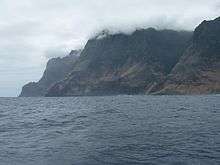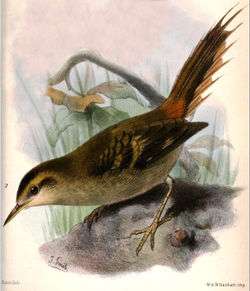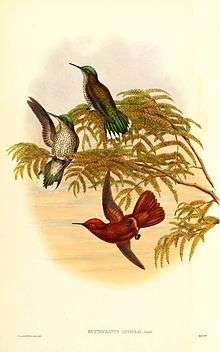Alejandro Selkirk Island
| Native name: <span class="nickname" ">Isla Alejandro Selkirk | |
|---|---|
|
A map of Alejandro Selkirk Island | |
 | |
| Geography | |
| Location | Pacific Ocean |
| Coordinates | 33°45′04″S 80°47′00″W / 33.75111°S 80.78333°W |
| Archipelago | Juan Fernández Islands |
| Area | 49.5 km2 (19.1 sq mi) |
| Highest elevation | 1,329 m (4,360 ft) |
| Highest point | Cerro de Los Inocentes |
| Administration | |
| Demographics | |
| Population | 57 |
Alejandro Selkirk Island (Spanish: Isla Alejandro Selkirk), previously known as Más Afuera (Farther Out (to Sea)) and renamed after the marooned sailor Alexander Selkirk, is the largest and most westerly island in the Juan Fernández Archipelago of the Valparaíso Region of Chile. It is situated 180 km (100 nmi; 110 mi) west of Robinson Crusoe Island in the southeastern Pacific Ocean.
Geography



The island measures 11 km (7 mi) north–south and 6 km (4 mi) east–west, and has an area of 49.5 km2 (19.1 sq mi). It is densely wooded and very mountainous and is marked by ridges and numerous deep ravines lead to a steep, rugged coast on the east side of the island off which are tremendous depths. The coastal cliffs are up to 1,000 m (3,281 ft) high. The south, west and north sides of the island have sandy strips of beach which extend 161 m (528 ft) offshore in places. The highest peak, Cerro de Los Innocentes, rises to 1,650 m (5,413 ft) in the southwest part of Alejandro Selkirk Island, where there is also a prominent rock with a hole through it.
Landing is possible near the center of the east shore at Quebrada Sánchez (Sánchez Ravine), and at the foot of Quebrada Las Casas (La Casas Ravine) 33°45′S 80°43′W / 33.750°S 80.717°W), where there is a boat slip and buildings of the former penal colony. Anchorage can be taken about 0.3 mi (483 m) east-northeast of Quebrada Sánchez (33°43′S 80°44′W / 33.717°S 80.733°W), in depths of 40.2 m (131.9 ft) to 49.4 m (162.1 ft). The ravine is recognized by a white patch on a hill near it. Anchorage can also be taken, in depths of 31.1 m (102 ft) to 50 m (164 ft), with sand bottom, off Rada de la Colonia.[1]
Dating of rocks on the island show that it is the youngest of the Juan Fernández Islands at an age of 1 – 2 million years old. Due to its young age, the island shows little evidence of erosion. According to some early reports, now disputed, about 59 km (37 mi) southwest of the island is the submerged Sefton Reef (36°43′S 83°15′W / 36.717°S 83.250°W), almost reaching sea level, and 47 km (29 mi) to northwest, Yosemite Rock (32°04′S 83°14′W / 32.067°S 83.233°W). Podesta Island, once reported to lay farther to the west, is a phantom island.
Climate
Alejandro Selkirk has a subtropical climate,[2] moderated by the cold Humboldt Current and the southeast trade winds. Temperatures range from 3 °C (37 °F) to 34 °C (93 °F), with an annual mean of 15.4 °C (59.7 °F). Higher elevations are generally cooler. Average annual precipitation is 1,081 mm (42.6 in), varying from 318 mm (12.5 in) to 1,698 mm (66.9 in) year to year. Rainfall is higher in the winter months, and varies with elevation and exposure; elevations above 500 m (1,640 ft) experience almost daily rainfall.
Flora and fauna
The Juan Fernández fur seal is known to have existed during the late 17th century on the island with the population of the seals on Alejandro Selkirk Island and Robinson Crusoe Island believed to be in excess of four million by the late 17th century. A census of 1797 estimated a population 2 – 3 million fur seals.[3] The species was hunted to near extinction by the 19th century and was thought to be extinct for 100 years until 200 were found on the island in 1965. Since then, the population has grown steadily at 15% to 20% every year.[4] The Masafuera rayadito is endemic to Alejandro Selkirk and one of the rarest South American birds with only 140 individuals left.[5] The Alejandro Selkirk firecrown Sephanoides fernandensis leyboldi an endemic subspecies of the Juan Fernández firecrown became extinct in 1908 by feral goats and other introduced animals.
The flora on the island is in the Fernandezian Region Floristic Region, in the Antarctic Floristic Kingdom, but often also included within the Neotropical Kingdom. Endemic plant families include Lactoridaceae, with endemic plant genera also found.[6]
History
Throughout much of its history, the island has been uninhabited. There was formerly a penal settlement along the middle of the east coast, at 33°45′49″S 80°45′27″W / 33.76361°S 80.75750°W. About 20 buildings can be made out on detailed satellite images.[7] The settlement was operative from 1909. It initially housed 190 criminals, while there were as many as 160 political prisoners from 1927 to 1930. The penal colony was abandoned in 1930.[8] Recently, the island has seen regular settlement, with 57 people living on the island as of the 2012 census.
In 1966 the Chilean government renamed Isla Más Afuera as Alejandro Selkirk Island, with Isla Más a Tierra becoming Robinson Crusoe Island. Alexander Selkirk was a Scottish sailor who was marooned as a castaway on Más a Tierra (then uninhabited) from 1704 to 1709. His story of survival likely inspired the 1719 novel Robinson Crusoe by Daniel Defoe.[9]
In popular culture
The author Jonathan Franzen wrote an essay in the The New Yorker about his brief stay on the island while mourning the suicide of his friend and fellow author David Foster Wallace.[10]
See also
- Flora of the Juan Fernández Islands
- Endemic flora of the Juan Fernández Islands
- Endemic fauna of the Juan Fernández Islands
References
- ↑ Sailing Directions Enroute, Vol. 125, West Coast of South America
- ↑ Corporacion Nacional Forestal de Chile. "Parque Nacional Archipiélago de Juan Fernández". Retrieved 27 May 2010.
- ↑ Ronald M. Nowak (1999). Walker's Mammals of the World. JHU Press. p. 846. ISBN 0-8018-5789-9.
- ↑ A. Rus Hoelzel (2002). Marine Mammal Biology: An Evolutionary Approach. Blackwell Publishing. p. 330. ISBN 0-632-05232-5.
- ↑ Gonzalez J. (2014). Phylogenetic position of the most endangered Chilean bird: the Masafuera Rayadito (Aphrastura masafuerae; Furnariidae). Tropical Conservation Science. 7:677–689.
- ↑ Dieter Mueller-Dombois; Francis Raymond Fosberg (1998). Vegetation of the Tropical Pacific Islands. Springer. p. 610. ISBN 0-387-98313-9.
- ↑ Satellite image
- ↑ Maura Brescia de Val (2004). Selkirk Robinson: El mito: a tres siglos del desembarco del solitario en Isla Robinson Crusoe (1704–2004). Mare Nostrum. p. 245. ISBN 956-8089-04-7.
- ↑ Severin, Tim (2002). In Search of Robinson Crusoe. New York: Basic Books. pp. 17–19. ISBN 978-046-50-7698-7.
- ↑ Franzen, Jonathan. "Farther Away". The New Yorker. Retrieved 24 December 2011.
External links
| Wikimedia Commons has media related to Alejandro Selkirk Island. |
- Robinson Crusoe, Moai statues and the Rapa Nui: the stories of Chile’s far-off islands
- Geographical names on Alejandro Selkirk Island
Coordinates: 33°45′04″S 80°47′00″W / 33.75111°S 80.78333°W
.jpg)